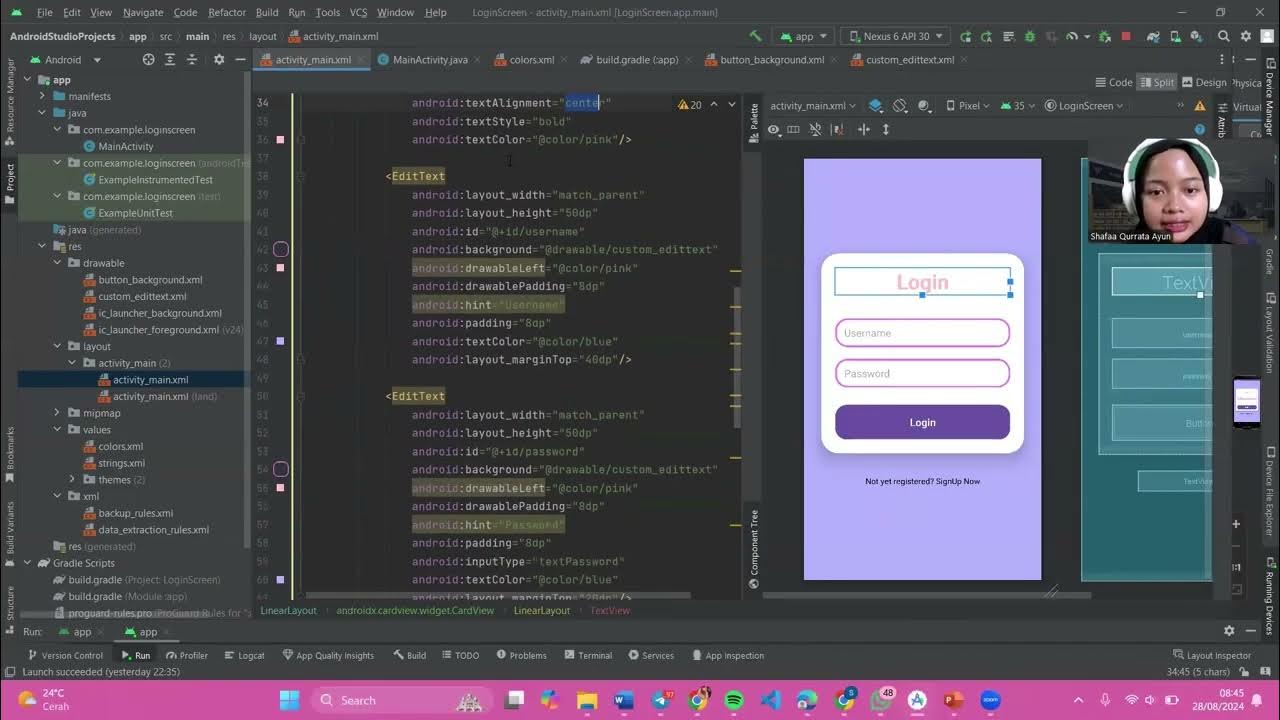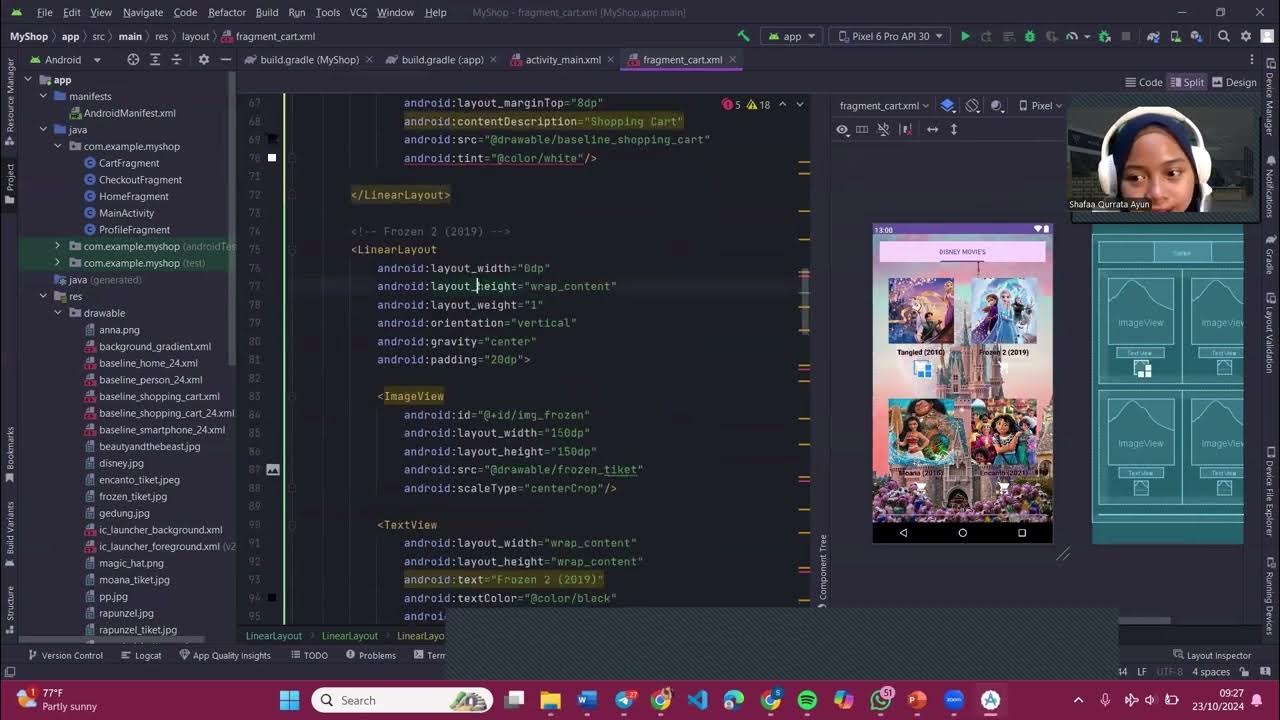PGPB Acara 5 Spinner, Date Picker, dan Time Picker
Summary
TLDRThis video demonstrates an Android app for spatial programming, focusing on the use of a Spinner, DatePicker, and TimePicker. The app allows users to select dates, times, and statuses (e.g., Present, Late, Sick) with an intuitive UI. The script covers both XML layout setup and Java code implementation for managing user inputs and validation. A live demo showcases the app in action, where the user selects a date, sets a time, and submits their status, receiving a confirmation message. The video is a comprehensive guide to implementing these components in an Android project.
Takeaways
- 😀 The demonstration video explains a Geospatial Programming Practicum focusing on Android mobile device features like Spinner, DatePicker, and TimePicker.
- 😀 The app interface includes multiple interactive elements such as a calendar, time picker, and dropdown menu for status selection.
- 😀 Spinner, DatePicker, and TimePicker are essential UI components for allowing quick and intuitive data input in Android apps.
- 😀 DatePicker enables users to select a specific date, which is displayed and adjustable in the app interface.
- 😀 TimePicker allows users to select a time in either 12-hour or 24-hour format, providing flexibility in time selection.
- 😀 The status dropdown provides four options for user input: 'Hadir Tepat Waktu' (On Time), 'Sakit' (Sick), 'Terlambat' (Late), and 'Izin' (Permission).
- 😀 The app uses Android Material design principles to create a clean, user-friendly interface with clear visual hierarchy.
- 😀 XML layout elements like LinearLayout, CardView, and TextView are used to structure the UI, ensuring a functional and visually appealing design.
- 😀 The Java code in the app handles interaction logic, such as managing date and time selection, validating user input, and submitting data.
- 😀 The app performs validation checks on input fields, displaying error messages if required fields (e.g., time, status) are not filled out.
- 😀 The app successfully demonstrates mobile data input with dynamic interactions, such as selecting date, time, and status, and receiving confirmation of data submission.
Q & A
What is the main objective of the demonstration?
-The main objective of the demonstration is to showcase a GeoSpatial programming practical implementation on a mobile device, specifically for attendance tracking using Android components such as Spinner, DatePicker, and TimePicker.
What are the key Android components used in this project?
-The key Android components used in the project are Spinner, DatePicker, and TimePicker. These components allow users to select attendance status, date, and time inputs efficiently.
How is the `Spinner` component used in the application?
-The `Spinner` component is used as a dropdown menu to select the attendance status from predefined options like 'Hadir', 'Tepat Waktu', 'Sakit', 'Terlambat', and 'Izin'.
What is the purpose of the `DatePicker` component?
-The `DatePicker` component allows the user to select a date from a calendar interface, which is used for inputting the attendance date in the application.
How does the `TimePicker` component function in this app?
-The `TimePicker` component allows users to select a specific time in either 12-hour or 24-hour format. It helps in recording the exact time of attendance, ensuring accurate data input.
What is the role of the `MainActivity.java` file in the app?
-The `MainActivity.java` file is responsible for initializing and controlling the app's UI components, including capturing user input for the date, time, status, and additional remarks. It also handles validation and submission of the form.
What validation steps are included in the app's code?
-The app includes validation steps to ensure that the user selects a time, status, and enters a description before submitting the form. If any field is left unfilled, an appropriate prompt message is displayed.
How does the app display a confirmation message after the form is submitted?
-After the user clicks the 'Submit' button, the app displays a confirmation message with the date, time, and status of the attendance, such as 'Presensi berhasil dilakukan jam 09:23 pada tanggal 25/09/2024'.
What physical device was used to demonstrate the app?
-The demonstration was conducted on a physical Android device, specifically a Nexus 6, which was connected via USB Type-C for testing the app's functionality.
What happens when the user interacts with the calendar view in the app?
-When the user interacts with the calendar view, they can select a specific date. The selected date is dynamically updated and displayed on the screen to indicate the chosen attendance date.
Outlines

This section is available to paid users only. Please upgrade to access this part.
Upgrade NowMindmap

This section is available to paid users only. Please upgrade to access this part.
Upgrade NowKeywords

This section is available to paid users only. Please upgrade to access this part.
Upgrade NowHighlights

This section is available to paid users only. Please upgrade to access this part.
Upgrade NowTranscripts

This section is available to paid users only. Please upgrade to access this part.
Upgrade NowBrowse More Related Video

PGPB Acara 1 Linear Layout

PGPB Acara 8 Recyler View

PGPB Acara 7 Bottom Navigation View dan Fragment

Create an Android APP in MINUTES by FREE AI 📱 EASY Tutorial with Cursor and Android Studio

Monitoring Suhu Dan Kelembaban Menggunakan ESP32 + DHT22 Dengan Protokol MQTT

PGPB Acara 6 TabLayout, ViewPger, dan Menu Options
5.0 / 5 (0 votes)